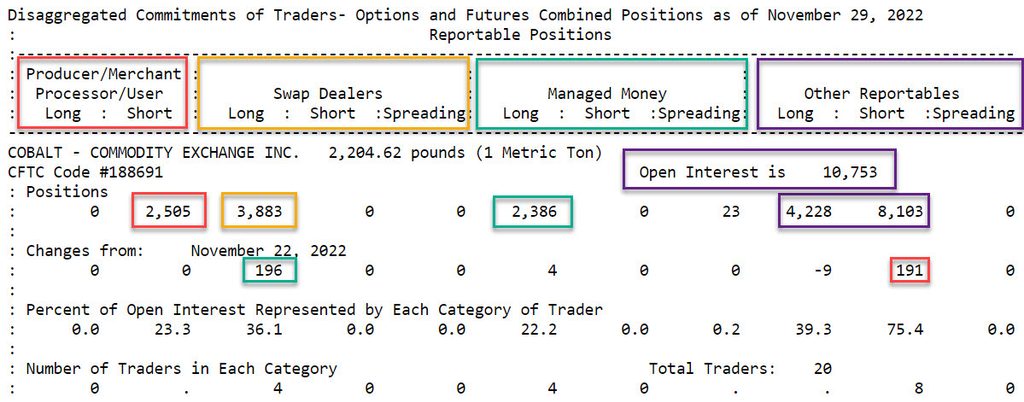It’s not easy to find valuable information. While prices are critical, their history only provides a piece of the puzzle in determining the next market move. Sentiment helps augment your view by allowing you to take a market pulse. One of the best ways to gauge futures market sentiment is to understand the information described in the Commitment of Traders report.
Broader use of futures contracts drives liquidity
As more traders accept a futures contract as a benchmark for the industry, open interest begins to grow. Open interest is the number of outstanding futures and options on futures transactions that have not been settled or closed.
For example, if you open a new position by purchasing a cobalt futures contract and do not sell it, your futures contract is counted as part of open interest. When there are more than 25 sizeable open interest holders, the Commodity Futures Trading Commission begins to report volume and open interest information.
The Commodities Futures Trading Commission (CFTC), a US government independent agency, reports the Commitment of Traders (COT) report weekly.
Why would you want to know who is trading what?
The COT report allows you to derive some sentiment information and evaluate whether producers are hedging or managed funds are active. The report can also tell you whether swap dealers or financial institutions are involved in providing liquidity.
What information is in the Commitment of Traders report?
The report is usually released by the CFTC every Friday and generally reports information as of the prior Tuesday. The data from the CFTC comes in a report format with few bells and whistles.
Before we dig into the report, let’s review a few basics.
The COT sorts the transaction that occurred during the week and adds or subtracts weekly volume from open interest by trader category.
When a trader opens a position by purchasing a futures contract, their position is “long.” When a trader opens a position by selling a cobalt futures contract, their position is “short.” If a trader opens a position with a futures contract purchase and simultaneously opens a position by selling another futures contract with a different maturity date, their position is referred to as “spreading.”
What can the COT report tell you?
There are several pieces of information that you can derive from the COT report.
For example, the COT report released for the reportable position date November 29, 2022, shows that producers/merchants are short. That likely means that producers are hedging their inventory.
The report also shows that swap dealers, generally financial institutions, are long cobalt futures contracts trading on the CME. Banks typically do not take an outright directional risk, which likely means they are short over-the-counter swaps and have used the futures market to hedge their short swap position exposure.
Another piece of valuable information is that managed money, generally viewed as hedge funds or commodity trading advisors, are long cobalt futures. Hedge funds typically take directional views, meaning they might speculate that cobalt futures will rise.
One last piece of open-interest information is positions held by “other reportables.” This category is left ambiguous, as it does not fall into commercials, managed money, or swaps dealers.
For example, a parent organization might not set up separately reportable trading entities to handle their different businesses or locations. In such cases, there will not be a separate Form 40 to allow the CFTC to determine that entity’s proper disaggregated commitment of traders classification.
What do changes in volume mean?
The COT report focuses on open interest, but futures contract volume information is also available. For example, on the November 29, 2022 report, you can see that nearly all of the long “swaps dealers” purchases of cobalt futures were offset by sales of cobalt futures contracts by “other reportables.”
Significant changes in volume, especially by swap dealers, indicate that liquidity is likely rising or falling.
How can open interest help you hedge?
While the information that is provided is objective, the analysis of what the data means is subjective.
Here are some tips.
The COT report can be used as a contrarian sentiment indicator.
The positions initiated by “managed money” are generally speculative. They will eventually exit their futures positions if the change in the futures contract prices generates a significant unrealized loss.
If the open interest is skewed (meaning the long position held by “managed money” is much greater than the short position), there is a chance of a rush to the door to exit quickly. The market might be poised for a short squeeze if the “managed money” short position is much larger than the long position.
Producers/merchant processors are more likely to hold on to their positions as they are usually a hedge to their underlying production.
Swap dealers are usually liquidity providers and generally exit futures contract positions when Over Counter (OTC) swaps roll off their books.
The bottom line
It’s not easy to find valuable commodity risk management information. Taking the market’s pulse is an essential piece of the puzzle in attempting to gauge future price movements. Certain information from the Commitment of Traders report (COT) can help you gauge sentiment.
The Commitment of Traders report is released weekly. The information categorizes volume and open interest on futures contracts by trader type. While the information is objective, the analysis can be used as a sentiment index to help traders make commodity hedging and trading decisions. If you want more information about cobalt futures contracts or hedging your battery raw material risk, contact our risk solutions team.





